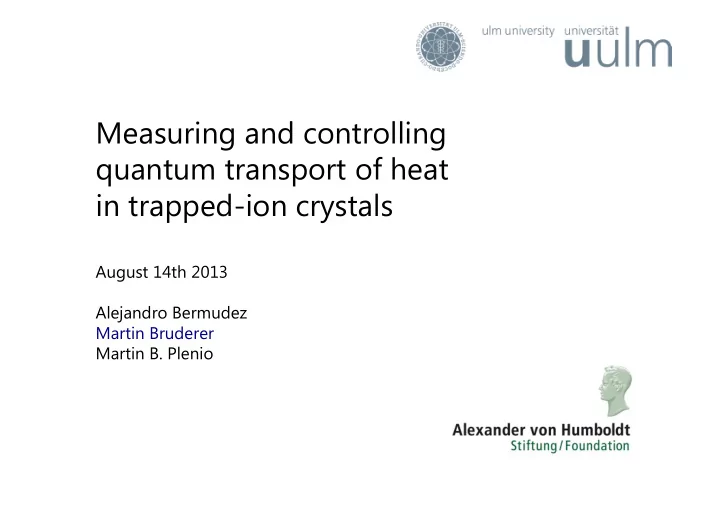

Measuring and controlling quantum transport of heat in trapped-ion crystals August 14th 2013 Alejandro Bermudez Martin Bruderer Martin B. Plenio
Nanoscale Electronic Transport Electrode Electrode Nano System (Source) (Drain) State-of-the-art in electronic transport Control current via bias & gate voltage � Measure electronic currents & � fluctuations using amperemeter (pA) Charge gives a handle on electrons � Pictures: Nanophysics Group, LMU München
Nanoscale Heat Transport 1. Measureing heat currents in nanoscale systems 2. 1. Controlled heating 2. Temperature measuremnt 3. Infer heat current from 1. & 2. � No ‘ampere meter’ for heat currents � No charge for heat 3. � Difficult to control heat currents K. Schwab, E. A. Henriksen, J. M. Worlock and M. L. Roukes, Nature 404 404 404 404, 974 (2000)
Trapped-Ion Crystal Toolbox Ion crystal is made of Bulk ions Bulk ions � � Transverse vibrations (vibrons) ⊳ coupled harmonic oscillators Reservoir ions (source & drain) Reservoir ions (source & drain) � � Cooled to different temperatures ⊳ induce thermal currents Probe ions Probe ions � � Vibrons coupled to internal states ⊳ ‘ampere meter’ for heat current
Trapped-Ion Crystal Toolbox Ion crystal is made of Bulk ions Bulk ions � � Transverse vibrations (vibrons) ⊳ coupled harmonic oscillators Reservoir ions (source & drain) Reservoir ions (source & drain) � � Cooled to different temperatures Transition from ballistic ⊳ induce thermal currents to diffusive transport Probe ions Probe ions � � ◾ Onset of Fourier’s law Vibrons coupled to internal states ⊳ ‘ampere meter’ for heat current
Trapped-Ion Crystal Toolbox Ion crystal is made of Bulk ions Bulk ions � � Transverse vibrations (vibrons) ⊳ coupled harmonic oscillators Reservoir ions (source & drain) Reservoir ions (source & drain) � � Cooled to different temperatures Transition from ballistic ⊳ induce thermal currents to diffusive transport Probe ions Probe ions � � ◾ Onset of Fourier’s law Vibrons coupled to internal states ⊳ ‘ampere meter’ for heat current
Vibron Hopping Model Additional functionality by using internal states � slow dynamics � fully controllable Tight- -binding model for vibron hopping binding model for vibron hopping Tight ⊳ small oscillations above ground state ⊳ coupling via dipole-dipole interaction J~1/d³ ⊳ energy (heat) transport by vibron hopping D. Porras and J. I. Cirac, PRL 93 93 93 93, 263602 (2004)
Heat Reservoirs Tight- -binding model for vibron hopping binding model for vibron hopping Tight Doppler cooling of edge ions at rate Doppler cooling of edge ions at rate ⊳ Effective cooling rate ⊳ Doppler cooling much faster than hopping
Spin-Vibron Coupling Couple internal states to vibrons (heat) Couple internal states to vibrons (heat) ⊳ internal states (spins) |↑〉 , |↓〉 ⊳ two-photon transition (1) (1) ⊳ ⊳ Photon Photon- -assisted tunneling assisted tunneling (2) ⊳ Probing & Disorder Probing & Disorder (2) ⊳
What physics can we do?
Ballistic Transport Vibron occupations in TQW Vibron occupations in TQW Assume and project dynamics onto state Ballistic tranport of vibrons across TQW Ballistic tranport of vibrons across TQW
Spin-Induced Binary Disorder Strong spin-vibron coupling Spins in superposition Tight- -binding model with disorder binding model with disorder Tight Binary diagonal disorder Binary diagonal disorder Exploit “quantum parallelism” B. Paredes, F. Verstraete & J. I. Cirac, PRL 95, 95, 95, 95, 140501 (2005) A. Bermudez, M. A. Martin-Delgado & D. Porras, New J. Phys. 12 12 12 12, 123016 (2010)
Fourier’s Law Ballistic Diffusive Homogeneous Inhomogeneous Clear signature for the onset of Fourier’s law Clear signature for the onset of Fourier’s law
Non-Invasive Ramsey Probe |↑〉 Operator couples weakly to spin Operator couples weakly to spin Spin evolution Spin evolution |↓〉 π /2 pulse free induction π /2 pulse 1 ⊳ Oscillations with frequency ~ 〈O〉 ⊳ Damping by fluctuations ~ 〈 δ O²〉 Measure occupations and thermal currents. Measure occupations and thermal currents. MB and D. Jaksch, New J. Phys. 8 8 8 8, 87 (2006) -1 G. B. Lesovik, F. Hassler & G. Blatter, PRL 96 96, 106801 (2006) 96 96
Thermal Quantum Dot Single site & thermal leads Single site & thermal leads Photon- -assisted tunneling assisted tunneling Photon Energy mismatch left/right ⊳ Full control of coupling to leads
Bosons versus Fermions Same averages for fermions and bosons Same averages for fermions and bosons Fano factor Current nL = 5 Fluctuations distinguish bosons/fermions Fluctuations distinguish bosons/fermions nR = 1 Fano factor Poissonian F = 1 Mandel Q = F - 1 Fermions Bosons Classical Fluctuations reveal bosonic Occupation 1 – 〈n〉 1 + 〈n〉 〈n〉 nature of thermal currents. Current* 1 – ½n L 1 + ½n L 1 * nR = 0 and symmetric coupling M. Esposito, U. Harbola & S. Mukamel, Rev. Mod. Phys. 81 81 81 81, 1665 (2009)
Nonequilibrium Schrödinger’s Cat Thermal currents more resilient to decoherence than electronic currents! Single- -spin heat switch spin heat switch Single ⊳ Spin of TQD controls current ⊳ Superposition of heat current on/off
Conclusions Thermal reservoirs Ampere meter & thermometer Doppler cooling Spin-vibron coupling Fourier’s law Zig-zag crossover Thermal diode & quantum dot Details in A. Bermudez, MB & M. B. Plenio, PRL 111 Details in A. Bermudez, MB & M. B. Plenio, PRL 111 111 111 111 111 111, 040601 (2013) 111 , 040601 (2013)
Recommend
More recommend